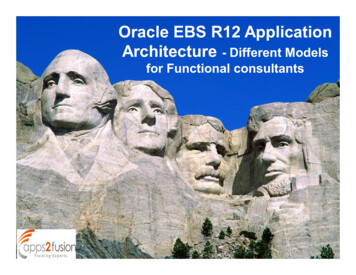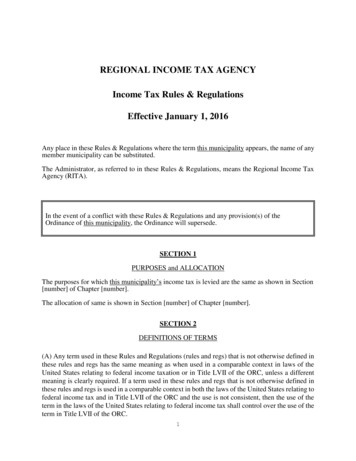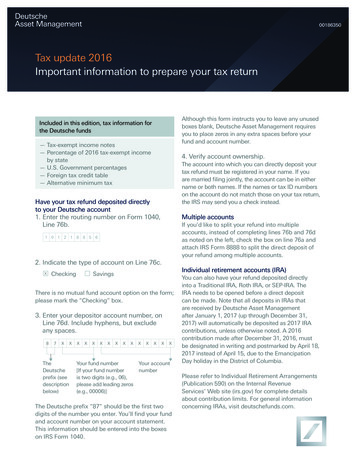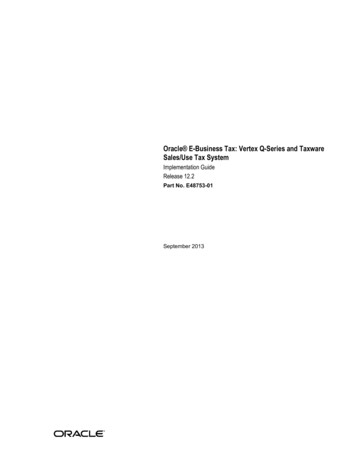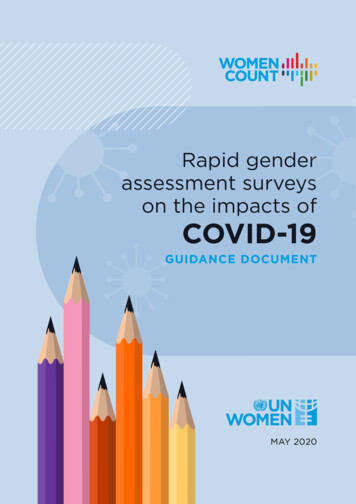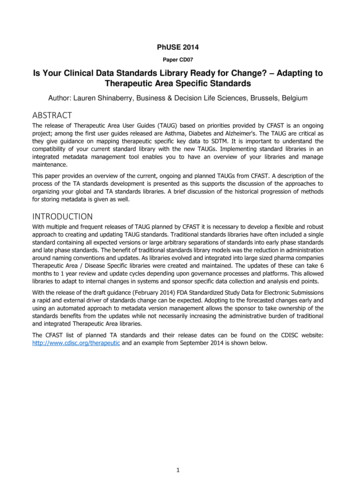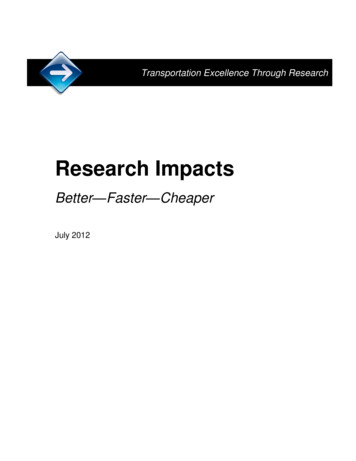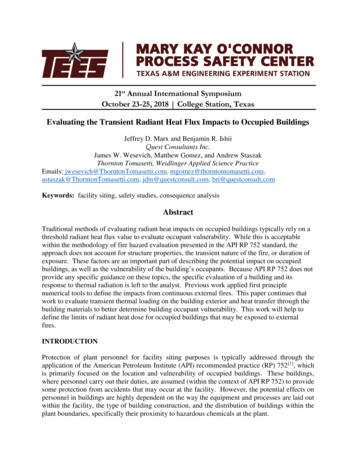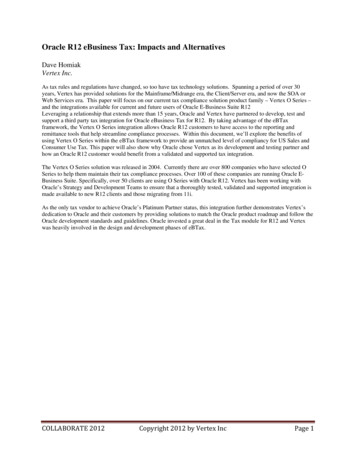
Transcription
Oracle R12 eBusiness Tax: Impacts and AlternativesDave HomiakVertex Inc.As tax rules and regulations have changed, so too have tax technology solutions. Spanning a period of over 30years, Vertex has provided solutions for the Mainframe/Midrange era, the Client/Server era, and now the SOA orWeb Services era. This paper will focus on our current tax compliance solution product family – Vertex O Series –and the integrations available for current and future users of Oracle E-Business Suite R12Leveraging a relationship that extends more than 15 years, Oracle and Vertex have partnered to develop, test andsupport a third party tax integration for Oracle eBusiness Tax for R12. By taking advantage of the eBTaxframework, the Vertex O Series integration allows Oracle R12 customers to have access to the reporting andremittance tools that help streamline compliance processes. Within this document, we’ll explore the benefits ofusing Vertex O Series within the eBTax framework to provide an unmatched level of compliancy for US Sales andConsumer Use Tax. This paper will also show why Oracle chose Vertex as its development and testing partner andhow an Oracle R12 customer would benefit from a validated and supported tax integration.The Vertex O Series solution was released in 2004. Currently there are over 800 companies who have selected OSeries to help them maintain their tax compliance processes. Over 100 of these companies are running Oracle EBusiness Suite. Specifically, over 50 clients are using O Series with Oracle R12. Vertex has been working withOracle’s Strategy and Development Teams to ensure that a thoroughly tested, validated and supported integration ismade available to new R12 clients and those migrating from 11i.As the only tax vendor to achieve Oracle’s Platinum Partner status, this integration further demonstrates Vertex’sdedication to Oracle and their customers by providing solutions to match the Oracle product roadmap and follow theOracle development standards and guidelines. Oracle invested a great deal in the Tax module for R12 and Vertexwas heavily involved in the design and development phases of eBTax.COLLABORATE 2012Copyright 2012 by Vertex IncPage 1
Strategy Change for Tax Partner IntegrationWhat has changed since Release 11i?In Release 11i and before, the integration with tax partners was supported only for some Order-to-Cash applications.The integration logic was coded and supported by Oracle for each tax partner separately. This involvedunderstanding each tax partner’s APIs, their parameters, when a particular API had to be called and what valuesneeded to be passed to that API in different contexts. Due to continuing enhancements to the tax partner APIs, thisintegration logic needed revision each time a tax partner delivered a new version of their APIs. This requiredunderstanding the changes made by the tax partner followed by a careful analysis of changes needed in theintegration logic.In E-Business Suite Release 12, Oracle provides a set of tax interfaces to integrate tax partner systems in a uniform,clearly defined, and consistent manner. Tax partners can build their solution using different technologies but arerequired to provide their services in compliance with the Oracle provided tax interfaces. Oracle’s goal is to provide aconfigurable solution allowing new tax partner services/APIs to be plugged in without building integration code byOracle. This configurable solution consists of three tax partner interfaces, each performing a specific tax functionnamely calculation of taxes, synchronization of document and tax information, or handling of document levelactions like canceling a document. These interfaces are the single point of integration for tax partners to integratewith all E-Business Suite applications.Also in Release 12, Oracle provides a set of additional attributes, at both transaction header and line levels, for itstax interfaces. Tax partners are expected to decide on whether they will or will not make use of these attributes toreceive additional information specific to them. If a tax partner decides to make use of these attributes, the taxpartner is expected to publish documentation that provides list of extensible attributes used by the partner along withthe purpose of each extensible attribute. The tax partners are also expected to handle any defaulting of values forthese attributes in their code. In order to improve the performance of the extensible attribute derivation, tax partnerneeds to provide guidance on when to re-populate the values of extensible attributes. Since these attributes aretransient, i.e. not stored in Oracle repository, tax partner system/user customization must maintain these values.COLLABORATE 2012Copyright 2012 by Vertex IncPage 2
eBTax – Framework for Building Tax RulesOracle EBTax Only Provides Half of the Tax Compliance SolutionOracle offers three recommended approaches to using EBTax:1) Use EBTax as the calculation engine and manually enter in the tax data that apply to your company2) Use EBTax as the calculation engine and subscribe to a validated partner’s sales tax rate file to import taxrates and geographical data into EBTax3) Configure EBTax to leverage a validated partner’s transaction tax application as the calculation engine andhave geographical data, tax rates and tax rules provided on a monthly basisUnless your company only operates in one state where only state tax is applied, the first approach should not beconsidered an option.The second approach may be a viable option if your company’s profile meets the following criteria: Nexus requirements in five or less states Single legal entity or operating unit structure Requirement only to tax sales orders and invoices Limited tax implications on the products and services you deliverIn this case, you may be able to research, build and maintain the pertinent tax rules for these limited productofferings and subscribe to a sales tax rate file service for updated tax rates and geographical data.COLLABORATE 2012Copyright 2012 by Vertex IncPage 3
There are several questions to ask before embarking on an EBTax implementation. What are the hidden costs of using EBTax by itself versus using EBTax with Vertex O Series? Will your tax department have the time and resources to research, build and maintain perhaps hundreds orpossibly thousands of tax rules? What is the consequence if the tax rules are configured improperly or are misinterpreted during the initialresearch?An incorrectly configured tax rule can lead to incorrect billings on your customer invoices, causing customer serviceissues and potential audit exposure.Relieving the Burden on Complex Tax ProcessesThere are several reasons why companies are choosing to implement Vertex O Series to address their complex taxcompliance processes. Both internal and external factors play a role in this decision. From an external standpointstate and local government audits, especially in the area of Consumer Use Tax, has been the leading factor.However, in recent years, Sarbanes-Oxley compliance has increasingly been another reason why companies havelooked to automate their tax processes. Stricter controls on business processes and the enforcement of theseprocesses have led many corporate executives to take tax decision and maintenance out of the hands of order entrypersonnel and back into the hands of the tax department.These tax departments, in many situations, are being pressured to reduce overall compliance costs, while also beingasked not to sacrifice accuracy. Because most taxes are viewed as a necessary evil, IT budgets for implementing taxsystems are very limited.It’s a common belief that Oracle EBTax provides the adequate functionality to maintain product taxability andrates. Decisions are made by the tax department and implemented by IT departments in the Oracle instance.However, many large corporations have multiple ERP or financial systems. Now tax departments are forced tomaintain two or three sets of tax data for their R12 instance and each ERP their company utilizes. This increases theoverall cost of internal tax compliance – exactly the opposite of what tax departments are being asked to reduce.In addition, the functionality provided in EBTax may work for companies with very limited tax exposure or“nexus.” These companies may not encounter complex taxing situations that require something more sophisticatedthan tax rates and customer or product exemption tables. Some examples of limited tax functionality in EBTaxsystems include: The inability to calculate origin based tax, quantity thresholds, or district taxesNo tax rate informationManual research and update process which is time consuming and costly on tax departmentNo address validation when creating new customers/vendorsThe inability to determine taxation based on how a product is being usedNo automated solution to prepare and file returnsOnce clients complete an internal review of their tax requirements and determine that a more full featured taxsolution is required, the next step is to understand exactly how Vertex works within the EBTax infrastructure. Laterin this document, we further review the features and benefits of Vertex O Series to address transaction taxcompliance activities. But first, let’s review how Vertex leverages the EBTax integration.Remember, it’s not Vertex “or” EBTax .it’s Vertex “with” EBTax.COLLABORATE 2012Copyright 2012 by Vertex IncPage 4
Vertex O Series with Oracle E-Business Suite R12Vertex made the decision to utilize the new functionality and integration points in eBTax rather than create acustomization using the old tax interface that was created for Oracle’s 11i applications more than a decade ago. Byfollowing the Oracle development guidelines, the Vertex integration is also fully supported by Oracle’s SupportCenter.Vertex O Series Tax Links for R12 serve as the dynamic integration channel between the Vertex O Series tax engineand the Oracle E-Business Suite. The innovative design and configuration options of Vertex O Series Tax Links forOracle allow tax departments to take control of tax decisions and make changes that affect their companies’ revenuewith minimal IT assistance. Following Oracle’s Development standards and guidelines as defined in the eBTax 3rdParty Tax Integration Guide, Vertex O Series is activated as part of your eBTax setup.While a client will leverage Vertex O Series to handle the main tasks generally associated with tax compliance,including rate and rule maintenance, product taxability, tax calculation and reporting, there are some configurationsteps within eBTax that initializes the integration and allows the transaction data to be passed to Vertex O Series forthe appropriate tax determination. Below we outline those high level configuration steps and also point out theadditional steps usually required for an eBTax implementation that are not necessary if you choose to activateVertex O Series.eBTax Setups for Service ProvidersUsing the standard Oracle integration for EBTax, Vertex needs to be “activated” as the Service Provider within theEBTax profile. In addition to establishing Vertex O Series as the Service Provider and Service Subscription, there aresome additional steps that need to be completed under the Tax Configuration Tab in eBTax. Need to create a Tax Regime Code for US Sales Tax – and designate that Vertex O Series will calculate taxes.This step is completed prior to running the Service Provider API, so that Vertex can be connected with aspecific Tax Regime. For instance, “US Sales Tax.” Need to create levels of tax that Vertex will calculate for the Tax Regime– State, County, City, Location (District)COLLABORATE 2012Copyright 2012 by Vertex IncPage 5
Oracle’s Tax field is mapped to Vertex Tax Jurisdiction attribute. So for the Tax Regime Code in Oracle you need tocreate tax lines for all the possible tax jurisdiction levels that can be returned.Once these tasks are completed, the remaining items across the Tax Configuration menu are pointed to Vertex indicating that these functions will be handled by O Series.All tax compliance activities are now maintained in Vertex O Series, which also handles the appropriate taxcalculation. As mentioned above, if you would choose to use the eBTax engine to calculate taxes, the followingadditional setups are required:Tax StatusTax Status is the taxable nature of a product in the context of a transaction and a specific tax on the transaction.Every tax status in Oracle E-Business Tax is defined under a tax and contains one or more tax rates. Duringconfiguration, the client defines exemptions/exceptions at jurisdiction level. Because Vertex provides taxabilityrules on thousands of products and services, there is no need to create and maintain in Oracle if using Vertex OSeries.Tax JurisdictionWithin eBTax, the client will need to manually setup each taxing jurisdiction or import data file from thirdparty.When using O Series, tax jurisdiction is returned from Vertex to Oracle. There is no need to maintainjurisdiction info for the tax regime code where the service subscription is enabled.Tax Recovery RatesFound in VAT or International Taxes, a recoverable tax is that which allows for full or partial recovery of taxespaid on purchases, either as a recoverable payment or as an offset against taxes owed. This would only need tobe setup if you have a requirement for charging and collecting taxes outside the US.Tax RatesTax Rates must be manually setup and maintained for each Tax Jurisdiction and for each tax event or importedvia a data file. With Vertex O Series, the tax rate is maintained and will be returned from Vertex during the taxcalculation. Again, there is no need to create and maintain Tax Rates in Oracle for the Tax Regime Code whichis using the Vertex service subscription.Tax Rulese-Business Tax lets you create a tax determination model to reflect the tax regulations of different tax regimesand the tax requirements of your business. You can create a simple tax model that makes use of default valuesCOLLABORATE 2012Copyright 2012 by Vertex IncPage 6
without extensive processing or create a complex tax model that considers each tax requirement related to atransaction before making the final calculation. Because tax logic (max taxes, tiered taxes, modified originstates, etc) is maintained by Vertex, there is no need to setup and maintain tax rules in e-B Tax if using VertexO Series.Vertex O Series Features and Benefits – Global Tax AutomationIdentifying the dynamics that are occurring in your company and those that match up with the capabilities of theVertex O Series system is the key to planning the most efficient and effective strategy for implementing anautomated tax compliance solutionConsider the following factors and trends that may be taking place within your company: Management of consumer use tax is becoming a high priority within the tax department.Company growth has resulted in expanded international operations and value added tax is no longermanageable as a manual effort.Evaluations of the current Oracle implementations are occurring and upgrades to newer versions are in theplanning stages.Merging operations of acquisitions to a centrally managed structure is on the planning horizon.A new business initiative such as a new on-line storefront or purchasing system will be implemented withweb technologies.Transactional tax management for multiple divisions will be centralized in a single corporate taxdepartment.The IT department has begun a strategy of adopting Web Services technologies for interoperability amongapplications.The IT department has initiated a strategy to reduce maintenance costs across the organization by limitingapplication support on client stations.Another consideration for planning a migration is the modularity of Vertex O Series that allows for a gradualimplementation if necessary. For example: Divisions can be added seamlessly over timeAdditional connections to ERP/Financial systems can be added to a central instance as neededImplementation can start with sales tax, expand to consumer use tax, and then value added tax as theproject requirements growThis modular approach allows for a staged progression to full transaction tax automation that can be matched toyour organization’s timeline, with low overhead for each planned stage.When evaluating a plan for implementation, the following benefits of Vertex O Series will likely be a consideration:EFFICIENT MANAGEMENT OF TRANSACTION TAX PROCESSESAs the tax department becomes more efficient, effectiveness within the organization is increased, costs associatedwith tax administration are decreased and the overall value of the tax department to the company is increased. Theright choice of a tax automation system will be a key driver to achieve tax processing efficiency. Getting to theinformation needed to perform tasks quickly and easily translates into the tax department’s ability to focus on highvalue deliverables.Vertex O Series puts all of the tasks associated with the management of transaction taxes at the fingertips of the taxprofessional through a single user interface, Vertex Central. From this browser-accessible user interface the taxprofessional can: Manage mappings to tax categories and overall taxability determinationCOLLABORATE 2012Copyright 2012 by Vertex IncPage 7
Test the taxability setup using a built-in transaction testerLook up sales, use, and value added tax rates stored in the systemRun reports of transaction result data for audit support, internal analysis or returns processingVertex provides a rich set of content with the Vertex O Series system. Content is updated monthly and supplied as adownloadable file that can be easily applied to the system. In addition to standard rates the following types of rulesare included in the data set: Taxability based on what the item is or how it is used with an associated tax result of: exempt, non-taxableor non-standard rateSitus determination (identifies the jurisdiction(s) that impose the tax for the transaction)Tiered tax ratesMaximum tax and maximum basis amountsQuantity based rulesPercentage basis rulesRounding rulesJurisdiction override rulesThe appropriate rules are applied to transactions as they are processed by the system based on the set of inputelements included on the request message. Vertex’s in-house research staff has developed and performs monthlymaintenance on a comprehensive data set of approximately 70,000 rules for over 8,000 tax jurisdictions coveringover 200 tax categories.With Vertex as your partner, your tax department can rest easy knowing that the necessary, time consuming researchfor compliance is accurate and up-to-date.GREATER CONTROLAmplified visibility and improved access to information provides increased value to users of the Vertex O Seriessystem. As user access increases, the need to have greater control over the system’s user environment becomes veryimportant and is managed in two ways: Role based security – an administrator defines the areas of the application that are accessible by different usersof the system. Activity Log – an on-line log tracks user activity by documenting the user name, date, and time of changes thatcould affect taxability.These features, when deployed appropriately, can become an important component of an effective internal controlenvironment. This benefits companies that are reviewing their control environments, particularly those subject to theSarbanes-Oxley Section 404 audit requirements.EXPANDED CALCULATION CAPABILITYAutomating sales tax calculations can be just the beginning of a fully automated transactional tax system thatincludes calculations for consumer use and value added taxes. Increased focus by many states on consumer use taxcompliance is making automation in this area of transaction tax a top priority. Unlike sales tax which is collectedfrom
Need to create a Tax Regime Code for US Sales Tax – and designate that Vertex O Series will calculate taxes. This step is completed prior to running the Service Provider API, so that Vertex can be connected with a specific Tax
